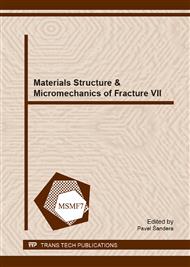p.409
p.413
p.417
p.421
p.425
p.429
p.433
p.437
p.441
Fatigue Response of Hybrid Ti/APC-2 Nanocomposite Laminates with Single-Edged Cracks
Abstract:
The aims of this study are to fabricate Ti/APC-2 hybrid composite laminates with and without (W/WO) nanoparticles and investigate the mechanical properties of laminates with single-edged cracks due to both tensile and cyclic tests. The mechanical properties such as ultimate tensile strength and longitudinal stiffness of original composite laminates W/WO nanoparticles were first obtained from the static tensile tests. However, the load-displacement diagrams were plotted for the crack laminates. The constant stress amplitude tension-tension cyclic tests were conducted to receive the S-N curves and fatigue data. The ultimate strengths for both Ti/APC-2 composite laminates W/WO nanoparticles were very close at varied crack length. Ti/APC-2 cross-ply nanocomposite laminates had better fatigue resistance than that of laminates without nanoparticles. The longer the crack length is, the more their properties are reduced. Also, the values of fracture toughness of both hybrid cracked laminates W/WO nanoparticles were obtained by rule of mixtures and found acceptable. Finally, in predicting crack growth rate and residual life, instead of commonly used Paris Law for metals, the modified method was adopted for hybrid cracked laminates. The prediction is not satisfactorily acceptable, even if most results are in good agreement with empirical data.
Info:
Periodical:
Pages:
425-428
Citation:
Online since:
November 2013
Authors:
Price:
Сopyright:
© 2014 Trans Tech Publications Ltd. All Rights Reserved
Share:
Citation:


